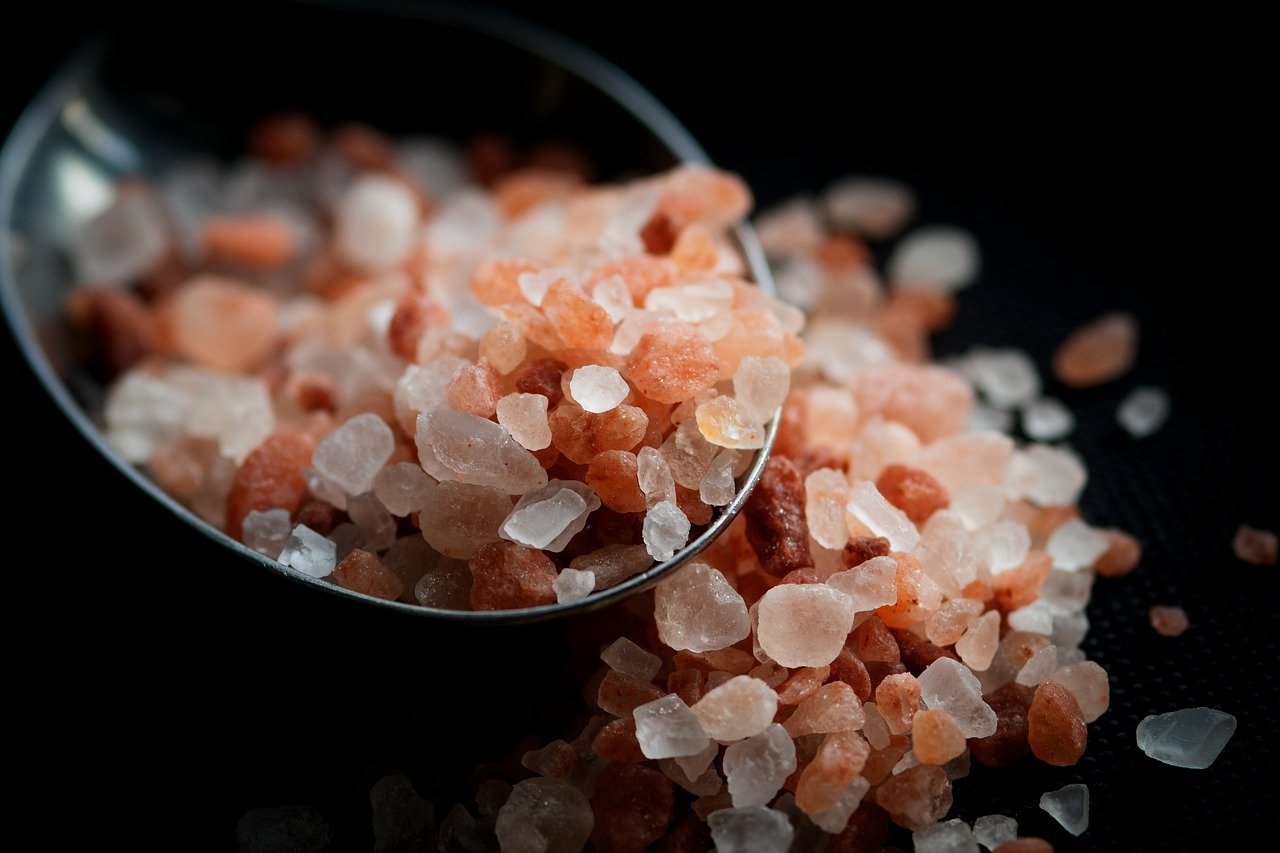Pink Himalayan salt is a type of rock salt known for its distinctive pink color and its association with health benefits and gourmet cuisine. Often marketed as a healthier alternative to table salt, pink Himalayan salt is sourced from the Himalayan region, primarily from the Khewra Salt Mine in Pakistan, one of the largest and oldest salt mines in the world. This ancient, unrefined salt is believed to be one of the purest forms of salt available, and its popularity has surged in recent years for both culinary and therapeutic purposes.
This article explores what pink Himalayan salt is made of, how it’s different from other salts, its potential health benefits, and its wide range of uses, from the kitchen to wellness practices.
What is Pink Himalayan Salt Made Of?
Pink Himalayan salt is primarily composed of sodium chloride (NaCl), just like other types of salt. However, what sets it apart from table salt and sea salt is its trace mineral content and its lack of additives. These trace minerals, such as iron, calcium, magnesium, and potassium, not only give the salt its characteristic pink hue but also contribute to its distinct flavor and potential health benefits.
1. Sodium Chloride (NaCl)
Like all salt, pink Himalayan salt is predominantly made up of sodium chloride, which is essential for many biological processes in the body. Sodium helps regulate fluid balance, nerve transmission, and muscle function. It also plays a critical role in maintaining blood pressure. While sodium is necessary for survival, consuming it in excess can lead to health issues like high blood pressure, so moderation is key.
2. Trace Minerals
The pink color of Himalayan salt is due to the presence of trace minerals, which make up around 2% of the salt’s composition. These minerals include:
- Iron: Iron is the primary element responsible for the salt’s pink hue. This mineral is vital for producing hemoglobin, the protein in red blood cells that carries oxygen throughout the body. Although the iron content in pink Himalayan salt is minimal, it contributes to its unique appearance.
- Magnesium: Magnesium is crucial for muscle and nerve function, maintaining a healthy immune system, and regulating blood sugar and blood pressure. It also supports bone health and helps prevent inflammation.
- Potassium: Potassium is essential for fluid balance, nerve signaling, and muscle contractions, particularly in the heart. It also helps offset some of the negative effects of excess sodium in the body.
- Calcium: Calcium is well-known for its role in building and maintaining strong bones and teeth. It also helps in muscle function, nerve transmission, and blood clotting.
- Other Trace Minerals: Pink Himalayan salt also contains small amounts of zinc, phosphorus, manganese, and selenium, all of which contribute to various bodily functions, although they are present in minute quantities.
The combination of these minerals is what gives pink Himalayan salt its slightly more complex flavor compared to regular table salt, as well as its distinct visual appeal.
3. No Additives
Unlike regular table salt, which is often refined and mixed with anti-caking agents (such as calcium silicate) and sometimes iodine, pink Himalayan salt is usually sold in its natural state, free from additives. This means it undergoes less processing, allowing it to retain more of its natural minerals.
Benefits of Pink Himalayan Salt
Pink Himalayan salt is often marketed as a healthier alternative to regular table salt due to its natural mineral content and lack of additives. While it shares many of the same properties as other salts, pink Himalayan salt does offer some unique benefits.
1. Contains Trace Minerals
As mentioned, pink Himalayan salt contains a variety of trace minerals that are not found in regular table salt. While the quantities of these minerals are small, they can contribute to overall health in a number of ways:
- Iron helps support healthy blood production and oxygen transport.
- Magnesium is essential for muscle relaxation, nerve function, and maintaining healthy bones.
- Potassium aids in balancing fluids and ensuring proper muscle contractions.
- Calcium supports bone and dental health.
Although the amount of these minerals in pink Himalayan salt is relatively low, they still add nutritional value that is absent from more heavily processed salts.
2. Lower in Sodium Per Volume
Because of its coarse grain structure, pink Himalayan salt is less dense than table salt, meaning that a pinch of Himalayan salt contains less sodium than a pinch of table salt. This can help reduce sodium intake for those concerned about their salt consumption, especially people managing high blood pressure or heart disease.
Since Himalayan salt crystals are larger, they also provide a more intense burst of flavor with less salt. This means you can use less salt overall without sacrificing taste, potentially helping to lower sodium consumption in your diet.
3. Electrolyte Balance
The combination of sodium and the trace minerals in pink Himalayan salt can help maintain proper electrolyte balance in the body. Electrolytes such as sodium, potassium, calcium, and magnesium are essential for hydration, nerve function, and muscle contraction. Pink Himalayan salt can be particularly beneficial after intense physical activity, as it helps replenish lost electrolytes due to sweat.
Some people mix a pinch of pink Himalayan salt in water as part of a homemade electrolyte drink to aid in recovery after workouts. This can be a natural alternative to store-bought sports drinks, which often contain added sugars and artificial ingredients.
4. Supports Detoxification
One of the purported benefits of pink Himalayan salt is its ability to assist in detoxification. While the body naturally detoxifies itself through organs like the liver and kidneys, some believe that pink Himalayan salt can support this process. It is often used in salt baths, where the minerals in the salt are thought to help draw out toxins from the skin and improve skin health.
When added to a warm bath, pink Himalayan salt can create a soothing and rejuvenating experience, helping to alleviate muscle tension, reduce inflammation, and leave the skin feeling soft. The magnesium and other trace minerals in the salt can also be absorbed through the skin, potentially providing additional health benefits.
5. Improves Respiratory Health
Another proposed benefit of pink Himalayan salt is its ability to improve respiratory health. Salt therapy, also known as halotherapy, involves breathing in air infused with tiny salt particles, often using pink Himalayan salt. Some people believe that inhaling these particles can help clear mucus, reduce inflammation, and relieve symptoms of asthma, allergies, and other respiratory conditions.
Although there is limited scientific evidence to fully support these claims, halotherapy is a popular alternative therapy for people seeking natural ways to manage respiratory issues. Many spas and wellness centers offer salt therapy sessions in Himalayan salt caves, where the walls and floors are lined with pink Himalayan salt to create a therapeutic environment.
6. Promotes Better Sleep
Some advocates of pink Himalayan salt believe that it can help promote better sleep by balancing the body’s hormones and supporting proper adrenal function. Since sodium plays a role in regulating blood pressure and hydration, some people argue that consuming a small amount of pink Himalayan salt before bed can help maintain these functions during the night, leading to deeper, more restful sleep.
Additionally, the trace minerals found in Himalayan salt, such as magnesium, may help promote relaxation and relieve muscle tension, which could further support better sleep.
7. Aesthetic Appeal and Culinary Uses
Beyond its health benefits, pink Himalayan salt is often favored for its aesthetic appeal and culinary uses. The striking pink color of the salt crystals makes it a popular finishing salt, often sprinkled over dishes just before serving to enhance both flavor and presentation. Its coarse texture provides a satisfying crunch when used on meats, salads, roasted vegetables, and even desserts like chocolate.
Pink Himalayan salt is also available in larger blocks, which can be used as cooking surfaces. Himalayan salt blocks can be heated on a stovetop or grill and used to cook or sear meats, fish, and vegetables. The salt imparts a subtle flavor to the food without overpowering it, and the block’s heat retention allows for even cooking.
8. Natural Alternative to Processed Salt
Since pink Himalayan salt is typically unrefined and free from additives like anti-caking agents and iodine, it’s often considered a more natural alternative to regular table salt. For people looking to reduce their intake of processed foods, using pink Himalayan salt is one way to incorporate a more natural ingredient into their diet.
That said, it’s important to note that while pink Himalayan salt offers trace minerals and lacks additives, it should still be used in moderation, just like any other salt. Excessive sodium intake can lead to high blood pressure and other cardiovascular problems, regardless of the type of salt consumed.
9. Skin Health and Exfoliation
Pink Himalayan salt is also popular in skincare routines. The coarse crystals make an excellent natural exfoliant, helping to slough off dead skin cells and reveal smoother, softer skin. Many skincare products, such as scrubs and bath salts, incorporate pink Himalayan salt for this reason.
The magnesium, calcium, and potassium in the salt may help soothe irritated skin and improve its overall texture. When used in combination with oils and other moisturizing ingredients, Himalayan salt scrubs can leave the skin feeling refreshed and rejuvenated.
10. Mood-Enhancing Properties
Pink Himalayan salt lamps have gained popularity for their supposed mood-enhancing and air-purifying effects. These lamps are made from large blocks of pink Himalayan salt with a light bulb placed inside. Proponents claim that when the salt lamp is heated, it releases negative ions that can improve mood, reduce stress, and purify the air by neutralizing pollutants and allergens.
While there is limited scientific evidence to support the idea that salt lamps produce enough negative ions to have a significant impact, many people find the warm, ambient light of Himalayan salt lamps to be calming and relaxing, making them popular in homes and offices.
Is Pink Himalayan Salt Really Healthier?
While pink Himalayan salt contains trace minerals and is free from additives, it’s important to keep expectations realistic when considering its health benefits. The amounts of trace minerals in the salt are quite small, meaning they are unlikely to make a significant difference in overall nutrient intake. For most people, the health differences between pink Himalayan salt and other types of salt are minimal.
However, pink Himalayan salt does offer certain advantages, such as its lower sodium content per volume due to its coarse structure, and its unprocessed nature, which makes it appealing to those seeking a more natural alternative to table salt. Additionally, its versatility in culinary and wellness practices makes it a popular choice for people looking to enhance their food and self-care routines.
Conclusion
Pink Himalayan salt is more than just a trendy seasoning—it’s a mineral-rich, natural alternative to regular table salt that offers a range of potential benefits. Whether you’re using it in the kitchen, for skincare, or as part of a wellness routine, pink Himalayan salt provides both aesthetic and functional value.
While the trace minerals in pink Himalayan salt add to its appeal, it’s important to remember that all types of salt should be consumed in moderation. Excessive sodium intake, regardless of the source, can lead to health issues like high blood pressure. That said, the unique flavor, texture, and appearance of pink Himalayan salt make it a versatile and enjoyable addition to your pantry or self-care regimen.




